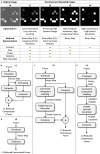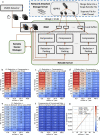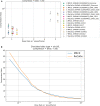A data reduction and compression description for high throughput time-resolved electron microscopy
- PMID: 33510168
- PMCID: PMC7844242
- DOI: 10.1038/s41467-020-20694-z
A data reduction and compression description for high throughput time-resolved electron microscopy
Abstract
Fast, direct electron detectors have significantly improved the spatio-temporal resolution of electron microscopy movies. Preserving both spatial and temporal resolution in extended observations, however, requires storing prohibitively large amounts of data. Here, we describe an efficient and flexible data reduction and compression scheme (ReCoDe) that retains both spatial and temporal resolution by preserving individual electron events. Running ReCoDe on a workstation we demonstrate on-the-fly reduction and compression of raw data streaming off a detector at 3 GB/s, for hours of uninterrupted data collection. The output was 100-fold smaller than the raw data and saved directly onto network-attached storage drives over a 10 GbE connection. We discuss calibration techniques that support electron detection and counting (e.g., estimate electron backscattering rates, false positive rates, and data compressibility), and novel data analysis methods enabled by ReCoDe (e.g., recalibration of data post acquisition, and accurate estimation of coincidence loss).
Conflict of interest statement
The authors declare no competing interests.
Figures







References
-
- Datta A, Chee SW, Bammes B, Jin L, Loh D. What can we learn from the shapes of secondary electron puddles on direct electron detectors? Microsc. Microanal. 2017;23:190–191. doi: 10.1017/S1431927617001635. - DOI
-
- Johnson, I. J. et al. Development of a fast framing detector for electron microscopy. In 2016 IEEE Nuclear Science Symposium, Medical Imaging Conference and Room-Temperature Semiconductor Detector Workshop (NSS/MIC/RTSD) 1–2 (IEEE 2016).
Grants and funding
- NRF-CRP16-2015-05/National Research Foundation Singapore (National Research Foundation-Prime Minister's office, Republic of Singapore)
- NRF-CRP16-2015-05/National Research Foundation Singapore (National Research Foundation-Prime Minister's office, Republic of Singapore)
- NRF-CRP16-2015-05/National Research Foundation Singapore (National Research Foundation-Prime Minister's office, Republic of Singapore)
- NRF-CRP16-2015-05/National Research Foundation Singapore (National Research Foundation-Prime Minister's office, Republic of Singapore)
- R-154-000-B35-133/National University of Singapore (NUS)
LinkOut - more resources
Full Text Sources
Other Literature Sources

